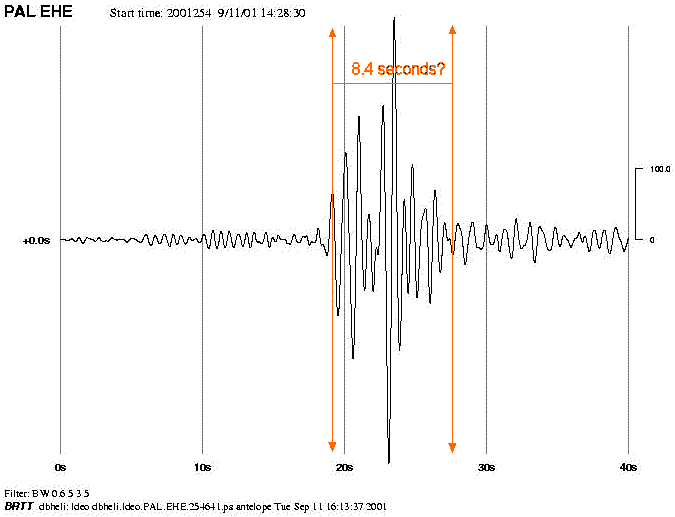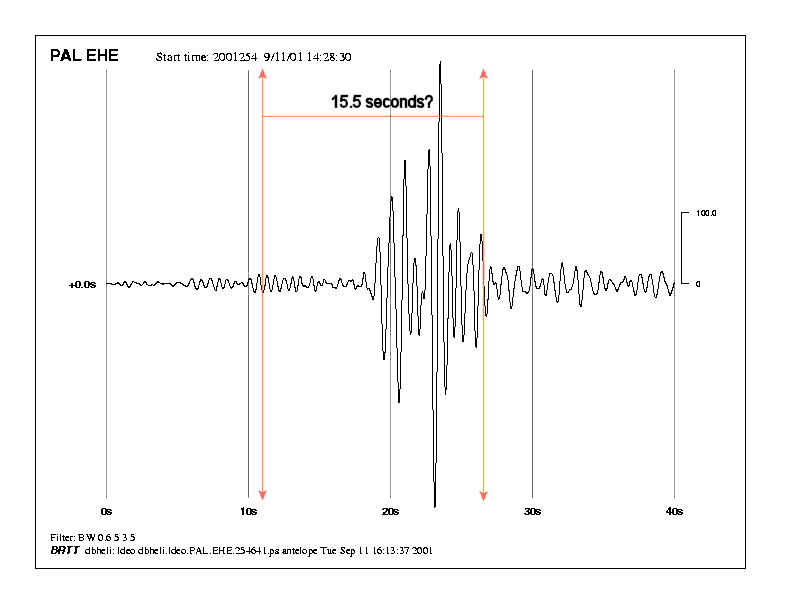|
It’s not a mainstream view, but some sites do claim that the towers fell in faster than freefall speeds (that’s usually specified as something like 8.4 seconds). They didn’t just make this figure up, either -- it comes from looking at the seismic record of the collapses. Look at this record of the North Tower fall closely and you’ll see the peak movements do seem to occur in less than a ten second period.

http://www.ldeo.columbia.edu/LCSN/Eq/WTC_20010911.html
This approach gives the appearance of being scientific, but unfortunately it suffers from exactly the same problem as video and audio methods of estimating the collapse time: there’s no clear idea of where the collapse starts and ends.
For instance, the 8.4 second time relies on us assuming that the first peak in the chart above, around 19 seconds, represents the story of the collapse. But how do we know this? There are signs of something happening long before then, perhaps from the 6 second point.
And then we have to assess when the collapse ends, and that’s not easy either. Does that last peak around 27 seconds really represent the last steel column hitting the ground, or could it stretch on for a second or two? Or 3? Or 4?
There is one way to try and resolve this. We know the start time of the graph (9:28:30 in New York), and we also know from LDEO that it took about 17 seconds for the signal to travel through the ground, therefore if the start time of the North Tower collapse can be determined by another means, then we’ll be able to see how the seismic record relates to other evidence.
And as it happens, we can do just that. 9-11 Research (http://911research.wtc7.net/wtc/analysis/collapses/freefall.html) point out that a CNN video recorded the moment of the collapse, and we calculate that their clock turns from 10:27 to 10:28 around 24 seconds before the tower began to fall (download the 16MB video here). That is, the collapse began around 10:28:24; adding 17 seconds for the signal to reach the LDEO station gives us 10:28:41; and that’s 11 seconds from the start of the chart. Which suggests the real collapse graph could be interpreted like this.

As you can see, there’s still a period where something seems to have been happening a little earlier, but then that’s no great surprise. Columns had to fail before the towers fell, and whether you believe they failed as the beginning of a progressive collapse, or through explosives, it’s not hard to believe that might be recorded in the few seconds before this start point.
This then suggests the first vibrations are movements being transferred through the core columns as the building falls, which are followed by big peaks as the heavy rubble hits the ground. We’ve chosen a point around the final peak to end the collapse, stretching the total collapse time to around 15.5 seconds, but suspect it actually lasted for a longer period: there’s just no way to tell for sure.
Obviously this calculation has many assumptions of its own: that the CNN clock is accurate, that the LDEO chart really does start at 10:28:30, that the seismic signals took 17 second to reach the recording station. And we suspect that there are some errors here; for example, it looks to us that a new seismic pattern started close to the 10 second point, than 11.
The analysis here correlates well with our audio estimates, though. And while it’s too “rough and ready” an approach to produce truly accurate results, we think this offers further support for times at the long end of the scale, 15 seconds or more, than the short.
|

